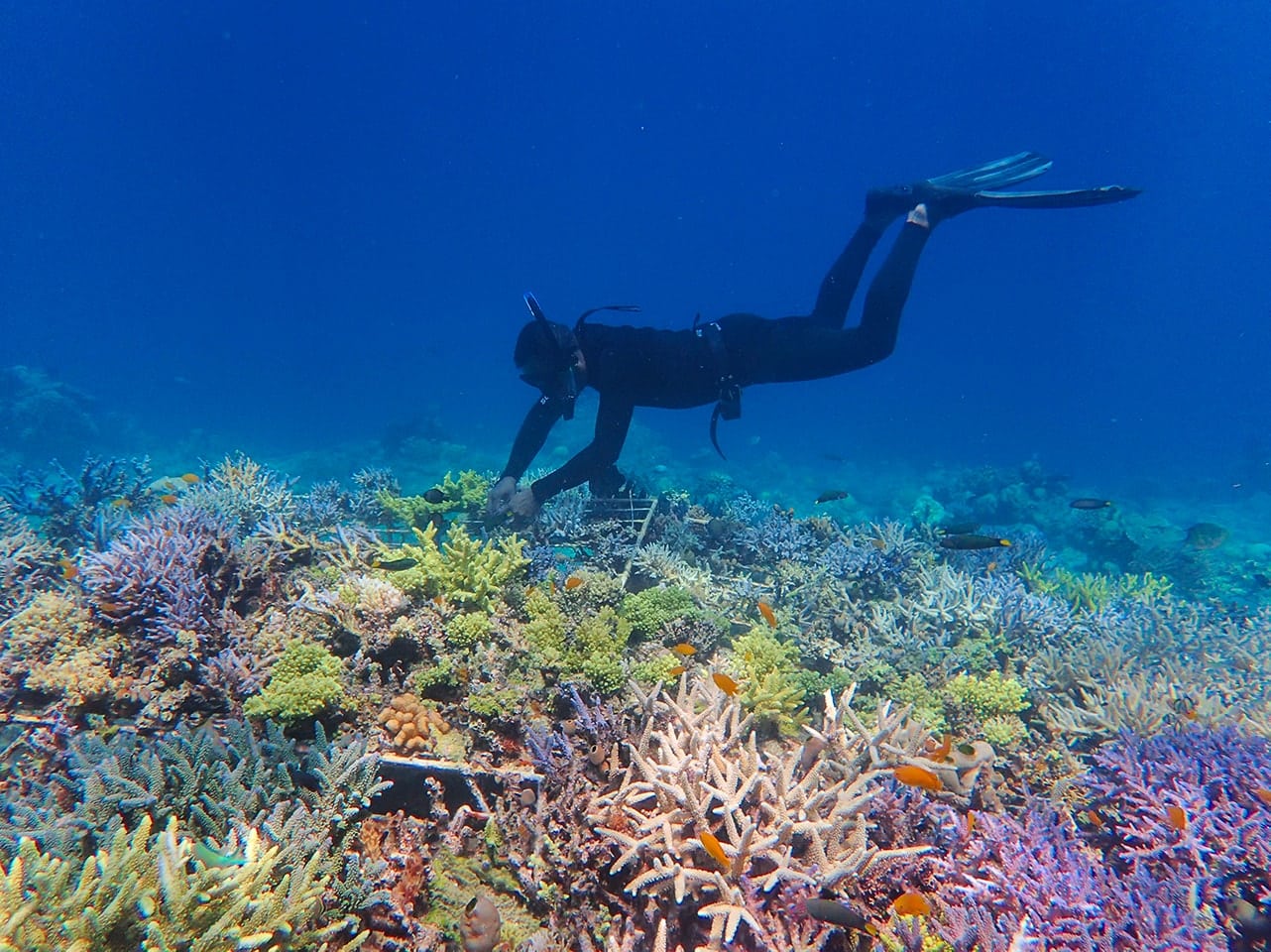Coral reef restoration: sexual or asexual reproductions of corals

Why restore coral reefs?
25% of marine biodiversity depends on or lives in coral reefs and 275 million people depend on them directly for a living. However, the disturbances they are facing, such as rising water temperatures or ocean acidification, are both becoming more frequent and intense [1]. However, the time between each disturbance is often far too short to allow them to recover [1]. This is why, in addition to actions against both climate change and harmful human disturbances, there is also a need to carry out restoration actions on damaged areas. To develop reef building corals, several restoration techniques exist based on sexual or asexual reproduction.
Life cycle of hard-skeleton corals (Scleractinian corals)
Hard corals are reef-building corals. The life cycle of hard corals is called biphasic [1]: an immobile phase where the polyp is attached to its coral (Figure 1.a) and a phase where the planula larva is mobile in the water (Figure 1.b).

Figure 1: The two phases of a hard coral’s life. (a) polyp phase. (b) planula larva phase. (Source: Randall et al. 2020 [1])
Asexual reproduction by budding
Each coral is made up of a multitude of polyps (each is about 1 to 3 mm in diameter) all genetically identical. Each polyp self-produces asexually (without fertilization) by budding [1]. An outgrowth of the “parent” polyp, called a sexual propagule, develops and gives birth to a new polyp, a clone that will be genetically identical to the parent polyp [1].
Once the coral reaches a certain age and size, the cycle of sexual reproduction begins and takes place 1 to 2 times a year in order to conquer new reefs [1].
Four modes of sexual reproduction in corals
The four modes of reproduction vary by species of coral and are: (1) hermaphrodism & spawning reproduction (2) gonochorism & spawning reproduction; (3) hermaphrodism & brooding reproduction ; and (4) gonochorism & brooding reproduction. Here are more details:
- Gonochorism is a mode of reproduction where an individual carries a single sex (male or female) throughout his or her life.
- Hermaphrodism reproduction is the opposite of gonochorism, because individuals possess both sexes or can change of sex during their lifetime.
- Corals also reproduce by spawning, they release gametes (sperm and ova) into water where fertilization and larval development will take place [1] (Figure 2).
- Finally, for brooding species, fertilization between male and female gametes is internal, and they will release a planula larva into the water (called planulation) once its internal development is completed [1].

Figure 2: (a). Multi-species coral surface slick at Lizard Island at 07:00, the day after spawning. (b). Photomicrography of a surface slick sample (a), showing various coral embryos and larvae. (Source: Randall et al. 2020 [1])
For coral species that reproduce by spawning (Figure 2.a), the release of gametes is often synchronized per minute, between individuals. This gamete release takes place only one to two nights in the year and is correlated with the lunar cycle. Indeed, the photoreceptors of the coral, depending on the intensity of the moonlight they are detecting, will induce or not the release of gametes. Many other factors come into play during this synchronization, but their implication still raises many questions from scientists. Some brooding species are known to use similar processes to coordinate planula larva release.
The benefits of sexual reproduction restoration
In a recent article by Randal et al. (2020), the feasibility and disadvantages of restoration using sexual reproduction were discussed. This increasingly advocated approach is to generate and deploy sexually produced corals [1].
In this article, they focused on corals that reproduce through spawning [1]. Indeed, achieving large-scale larval cultivation is possible here, simpler and more cost-effective than collecting coral larvae that reproduce by brooding [1].
A coral that has survived a bleaching episode will potentially have beneficial genetic characteristics such as temperature tolerance [1]. Having survived, he will be able, by sexual reproduction, to transmit this tolerance inscribed in his genes to his offspring according to Darwin’s theory of natural selection. This reproduction is said to be selective because it promotes the survival of the most adapted corals.
Therefore, restoration by sexual reproduction is precisely interesting because it naturally promotes genetic diversity, which is very important for the survival of corals [1]. Also, restoration approaches by sexual reproduction must promote reproduction between corals that have already been stressed or pre-adapted because, they have been shown to be more resistant to stress [1].
More corals could be produced for restoration through sexual reproduction if lunar and seasonal cycles and temperatures necessary for corals’ sexual development were artificially replicating.
Fragmentation: a technique used by Coral Guardian to restore coral reefs
Current coral restoration programs use the fact that each polyp is capable of self-producing. Indeed, they use the asexual method of coral reproduction to produce new corals and restore reefs [1].
This technique, called “coral gardening,” resembles the cutting method of a plant, although corals are animals. It involves removing a small part of the coral and transplanting it on degraded reefs or artificial reef structures [1] (Figure 3) because corals need a hard substrate to grow.

Figure 3: Coral Guardian restoration actions by fragmentation on a solid substrate (Source: Coral Guardian/Martin Colognoli)
Coral Guardian performs fragmentation restoration (asexual reproduction) but takes into account the important criteria of genetic brewing and pre-adapted corals. Indeed, on the same structure (Figure 3), we place corals from different parent colonies in order to promote this genetic diversity that we know is essential for the survival of corals. The diversity of corals on the same structure is also ensured because different species of corals are transplanted.
Corals are very sensitive to stress (thermal shock, fish, divers…). However, it has been proven that corals that have experienced a first stress will be more resistant to a second stress and therefore more adapted to survive. Therefore, Coral Guardian has adapted its methodology, and transplants corals that have already experienced a first stress.
These corals are more resilient but they are not indestructible. Indeed, they remain sensitive to stress and can die from it. That’s why, on one hand, Coral Guardian continues to optimize and improve its restoration approach over time to maximize coral survival. And on the other hand, we continue to raise awareness on coral protection, a key action if we want to reduce the stress caused by man and their impact on reefs.
Conclusion: what restoration techniques for the future?
First, it is important to stress that no restoration approach will be successful without rapid and effective efforts at the same time to slow the pace of ocean warming and acidification [1]. Restoration interventions are intended to provide a boost for nature to mitigate the decline due to disturbance and to accelerate the natural recovery of reefs [1].
It is also important to note that the success of coral restoration and adaptation interventions varies from species to species, from place to place, reef to reef and region to region, so the ecology of the restoration site must be studied first [1].
In the future, upcoming approaches for mass coral restoration would have a definite interest in combining the traditional (asexual reproduction) method of fragmentation with advances in the sexual production of corals [1].
Finally, restoration approaches must be economically viable and technically feasible for mass restoration to be achievable. However, with regard to this last point, one of the drawbacks remaining about sexual reproduction approaches, is that a lot of scientific research must still be carried out in order to find the best possible restoration technique [1].
[1] Randall, C. J., Negri, A. P., Quigley, K. M., Foster, T., Ricardo, G. F., Webster, N. S., … & Heyward, A. J. (2020). Sexual production of corals for reef restoration in the Anthropocene. Marine Ecology Progress Series, 635, 203-232.
Ces articles pourraient vous intéresser

Do clouds support us in coral protection?
Mystery in the Pacific: who saved coral reefs at the Society Islands? Could the presence of clouds in the sky improve the health of coral…
28 November 2023Tracking ocean temperatures in situ and from space
Written by: Florina Jacob and Laura Bastide Why monitor water temperature in coral restoration zones? Coral health is closely linked to water temperature. The…
26 June 2023
Sponsor Spotlight : Zepp Health
Tell us a bit about yourself 🙂 At Zepp Health, we’re on a mission to empower people to take control of their well-being. We…
19 June 2023
Donor spotlight : Charline Auvinet
Tell us a bit about yourself 🙂 After graduating a few years ago, I’m now a crime fiction editor. In this job, I have discovered…
17 January 2023
